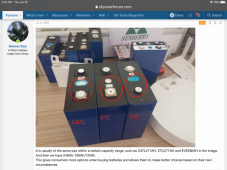clyndes
New Member
I ordered 8 of these on Feb 1st 2021 for $899.74 shipping included. I received them in Vermont USA on April 7th. I did run into the Chinese New Year holiday.
While I waited I made some cardboard prototypes of the cells and made my enclosures. I am using two Overkill Solar S4 120 Amp BMS.
After top balancing I did a capacity test and one battery of 4 cells gives me 270AH and the other gives me 277AH.
I do not know the manufacturer of these cells so I included a picture. Can anyone tell from the picture who made them? They have a barcode that says scratch, and there were small, hopefully cosmetic issues. The ad specified that they were new. I've gone through 2 full cycles and other than the less than advertised capacity they seem to be working fine.
I had originally thought I’d buy the SOK batteries but when they were out of stock decided to take the plunge and try making my own. These ended up costing about the same once all was said and done but have more AH and I understand them a lot better because of having to set them up. Hopefully I won’t regret going with VariCore.
I will post a follow up message with a description of my system and a few (quite a few) questions I have. I thought I would keep this short and to the point.

While I waited I made some cardboard prototypes of the cells and made my enclosures. I am using two Overkill Solar S4 120 Amp BMS.
After top balancing I did a capacity test and one battery of 4 cells gives me 270AH and the other gives me 277AH.
I do not know the manufacturer of these cells so I included a picture. Can anyone tell from the picture who made them? They have a barcode that says scratch, and there were small, hopefully cosmetic issues. The ad specified that they were new. I've gone through 2 full cycles and other than the less than advertised capacity they seem to be working fine.
I had originally thought I’d buy the SOK batteries but when they were out of stock decided to take the plunge and try making my own. These ended up costing about the same once all was said and done but have more AH and I understand them a lot better because of having to set them up. Hopefully I won’t regret going with VariCore.
I will post a follow up message with a description of my system and a few (quite a few) questions I have. I thought I would keep this short and to the point.

Last edited:





